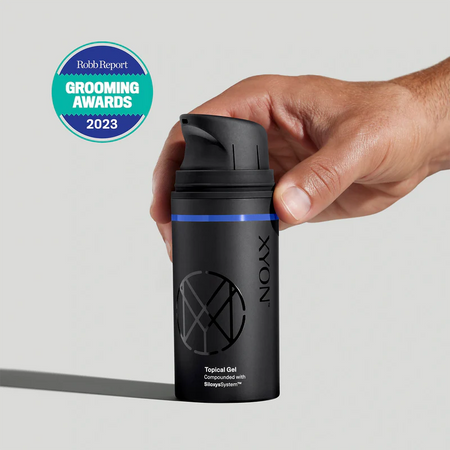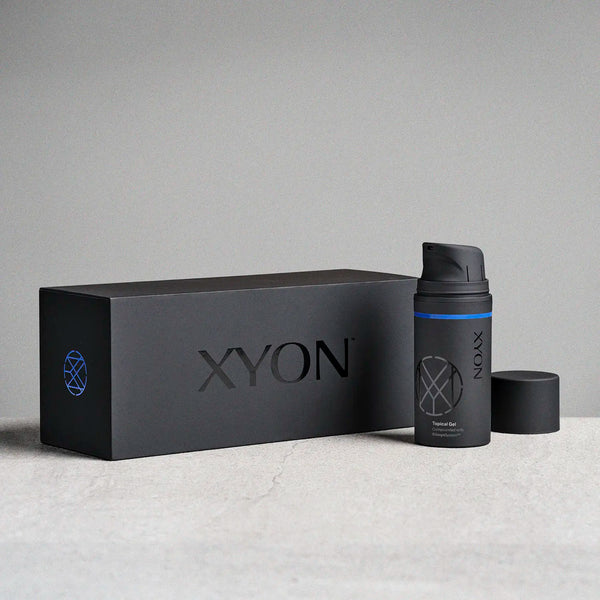Finasteride is a hair loss medication which is FDA and Health Canada approved in an oral 1mg dose for the treatment of pattern hair loss in men, but it can also be prescribed as a compounded topical medication following a consultation with a doctor. It works by blocking a specific enzyme from converting testosterone into the male hormone dihydrotestosterone (DHT), which helps to slow the progression of hair follicles shrinking in people who are at risk for balding.
How long does finasteride take to work?
If you’ve recently started finasteride or you’re contemplating whether to take it, one of the obvious questions you’ll want to know is how long it will take until you’ll see results. The timeline of hair regrowth or halting hair loss on finasteride can vary from person to person, so it can be difficult to give you an exact answer on what you should expect.
But we want to help, which is why we’ve created a brief timeline based on medical evidence in the literature, clinical studies, as well as other finasteride users’ experiences. It’s important to understand that everyone’s experience with taking finasteride can differ for a number of reasons, including genetics and biological differences that can affect how you respond to certain medications. This timeline is designed to give you a general overview.


Regrow your hairline with XYON's topical finasteride gel.
Our unique gel technology helps control absorption, keeping finasteride in the skin and out of the body.
1 month on finasteride
When you first start taking oral finasteride, your levels of dihydrotestosterone will begin to drop and this is because of the blocking action of the medication on the 5-alpha reductase enzyme. Research has proven that serum DHT levels drop significantly within the first 28 days of taking finasteride (Dallob et al, 1994).
Although these changes are happening beneath the surface, one month is not enough time for the hair follicles to have entered a new growing stage of the hair cycle, so you are unlikely to notice any real hair growth within this first month.
However, you may experience some hair shedding during this time. Initial shedding on finasteride is a normal response and it is actually a sign that the hair follicles are beginning to transition into the anagen (active growth) phase. As they make this transition, the existing hairs must be pushed out to make room for new, healthier hairs to grow.
3 months on finasteride
As you enter the 3-month mark, any shedding that you’ve experienced should be subsiding. If you’re still experiencing substantial hair shedding by this stage, we recommend consulting with your prescribing physician.
Hair growth is a marathon, not a sprint and 3-months isn’t typically quite long enough for your hair to have regrown enough for visible results. By this point, some people may start to feel discouraged about their progress but knowing that it’s normal to have no visible change at this time-point is a reminder for you to persevere.
There are countless threads online with people expressing their frustrations and even fear about not seeing results by this point in time. But we’re here to tell you that it’s generally not a cause for concern. Stick with the treatment plan and keep taking your medication as instructed by your doctor. In the meantime, taking regular photos of your hair can help you to track any progress, even if it’s minor.
Remember, if your hair loss hasn’t worsened since you started finasteride, this can still be seen as a success.
6 months on finasteride
It takes approximately 6 months of consistent treatment with finasteride for improvements to begin to become visible. We took to the most popular online forum for male pattern baldness to get a sense of the kind of results people were experiencing after 6 months on finasteride. The outcomes vary significantly.
For example, this post shared before and after images at the beginning of the hair loss journey and after 6/7 months on finasteride (XYON’s topical finasteride to be exact). He experienced great visible improvements in hair growth, with areas of thinning gaining back some of their density.

https://www.reddit.com/r/tressless/comments/191xfm0/xyon_fin_progress_photos_9_months_progress/
However, this is not a universal experience and your individual results may vary. Remember that consistency is key to hair growth, so keep it up, even if you haven’t yet noticed any changes.
1 year on finasteride
After one year on finasteride, you will likely see improvements in hair density. Clinical data has proven that the maximum benefits are seen from finasteride after 1-2 years of treatment, so even if you’ve noticed slight improvements, it may be a good idea to stick with it for another year. Remember, finasteride results last for as long as you take the medication and just because you’ve had positive results doesn’t mean that you can stop taking your treatment.
When searching online forums for people’s personal experiences after one year on finasteride, we noticed that there are significantly more people reporting positive results in comparison to the six-month mark. For example, this post shows a significant increase in hair density after this person experienced diffused thinning at a young age. They reported using 1mg finasteride daily and these were the results after a year of this treatment regimen:

https://www.reddit.com/r/tressless/comments/1554uyq/1mg_fin_only_1_year_progress_on_28m/
Another important thing to bear in mind on your finasteride journey is that the medication may work better or faster on certain areas of the scalp. This is because hair follicles can vary in their sensitivity to the hormone DHT depending on where they’re located on the scalp. Unfortunately, there is no exact science to determine which area of the scalp you’ll see the best results on, but in general the hairline tends to be the most stubborn area of hair loss to treat. Nevertheless, some people still experience excellent hair regrowth along the hairline with finasteride, as seen in this post:

https://www.reddit.com/r/tressless/comments/n6ds92/m24_finasteride_progress_pic_1_year_mark/
This patient reported that he took 1mg of finasteride daily, as well as a fish oil supplement daily. If you’re curious about natural supplements as an adjunct therapy to your hair loss medication, check out our page to learn more about which supplements are the best for your hair.
2 years on finasteride
By the 2-year point, it should be clear what the benefits of finasteride treatment are. You will also know by now whether you experience any side effects from taking finasteride and if so, whether this is something you are able tolerate. If you experience side effects on oral finasteride, compounded topical finasteride may be a better option for you as they may help limit systemic absorption which is associated with a lower risk of side effects.
After 2 years of taking medication, it naturally becomes a part of your daily routine making it feel like less of a ‘hassle’ and you’ll likely be pretty good at consistently taking it each day by now. We mention this because treatment adherence is a vital factor in your hair loss journey and reaching 2 years is a big milestone.
Here are some examples of results that might be possible after taking finasteride consistently for 2 years:

https://www.reddit.com/r/tressless/comments/rriuwg/my_2_year_and_6_months_progress_finasteride_1_mg/
This post to an online forum demonstrates results after taking finasteride for 2 years, This particular individual also explained that he didn’t see any visible improvements until at least 9 months into treatment. This highlights that it can take time and perseverance, but the end results may be worth it!

How to optimize results on finasteride
If you’re not seeing the results you had hoped for after using finasteride, there may be the option to add an additional medication to your treatment. In fact, emerging research has suggested that a combination of finasteride and minoxidil is more effective than finasteride on its own, after 12 months (Hu et al, 2015). To read more about the advantages of using minoxidil while taking finasteride, head to our blog post.
Additionally, maintaining a healthy diet with essential nutrients and exercising regularly are both important factors for the health of your hair. Making these lifestyle changes can help to give your hair the best chance of healthy growth throughout your finasteride treatment.
We spoke to Dr. Christina Han, a board-certified dermatologist and XYON’s Medical Director about the best ways optimize your results on finasteride and told us the following:
Be as consistent as possible in following the directions and using your treatment as outlined by your prescriber. Hair regrowth takes time and patience so keep at it. If you see shedding, try and not panic as this tends to be temporary. Finally, use complementary products that can help boost the results by selecting ingredients that target your area of concern – whether it is dandruff, hair loss, or breakage. A comprehensive regimen may include XYON’s performance shampoo, conditioner and scalp serum to optimize your results.
Takeaway on finasteride results
While there is no specific timeline for the results you should expect on finasteride (this is down to a variety of reasons, such as genetics) many people can expect to see some level of improvement in their hair loss after about 6 months. One of the most important parts of your finasteride journey is being consistent with your prescribed treatment. If you suspect that finasteride isn’t right for you or are concerned about possible side effects, speak to your doctor or hair loss specialist before stopping your medication. It could be that you need to give it some more time to see the benefits of finasteride, but your doctor can advise you on the next steps and be there to support you along the way.
References:
Dallob, A.L., Sadick, N.S., Unger, W., Lipert, S., Geissler, L.A., Gregoire, S.L., Nguyen, H.H.., Moore, E.C., Tanaka, W.K. (1994). The effect of finasteride, a 5-alpha-reductase inhibitor, on scalp skin testosterone and dihydrotestosterone concentrations in patients with male pattern baldness. The Journal of Clinical Endocrinology and Metabolism, 79(3), 703-6. 10.1210/jcem.79.3.8077349
Hu, R., Xu, F., Sheng, Y., Qi, S., Han, Y., Miao, Y., Rui, W., Yang, Q. (2015). Combined treatment with oral finasteride and topical minoxidil in male androgenetic alopecia: a randomized and comparative study in Chinese patients. Dermatologic Therapy. https://doi.org/10.1111/dth.12246



